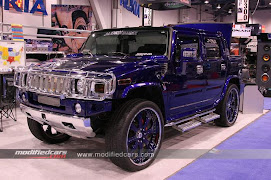
Joe Oros and his team were rushing to complete a design that would become in the prototype for the 1965 Ford Mustang. This is how Oros remembers it: I then called a meeting with all the Ford studio designers, including the truck designers. We talked about the sporty car for most of that afternoon, setting parameters for what it should look like -- and what it should not look like -- by making lists on a large pad, a technique I adapted from the management seminar. We taped the lists up all around the studio to keep ourselves on track. We also had photographs of all the previous sporty cars that had been done in the Corporate Advanced studio as a guide to themes or ideas that were tired or not acceptable to management.
Engineers use a series of templates to transfer body surfacesfrom a clay model to production tooling.Within a week we had hammered out a new design. We cut templates and fitted them to the clay model that had been started. We cut right into it, adding or deleting clay to accommodate our new theme, so it wasn't like starting all over. But we knew Lincoln-Mercury would have two models. And Advanced would have five, some they had previously shown and modified, plus a couple extras. But we would only have one model because Ford studio had a production schedule for a good many facelifts and other projects. We couldn't afford the manpower, but we made up for lost time by working around the clock so our model would be ready for the management review.It took us another two weeks or so to finish it. Lee Iacocca first saw it when it was about five-eighths to three-quarters complete. I met him at the studio door and talked with him about what we were trying to accomplish. I could tell he was really pleased with the concept we were on, but he was noncommittal. Still, our car won hands-down.
And we did it in under three weeks' time.
Oros' studio completed the winning design for the first Ford Mustang in three weeks.I guided the overall appearance, especially the front end, but Dave Ash, Gale Halderman, and John Foster did an outstanding job in guiding the Mustang's development with the various committees that came through the studio -- manufacturing, engineering, product planning.
Oros' studio completed the winning design for the first Ford Mustang in three weeks.I guided the overall appearance, especially the front end, but Dave Ash, Gale Halderman, and John Foster did an outstanding job in guiding the Mustang's development with the various committees that came through the studio -- manufacturing, engineering, product planning.
Charlie Phaneuf, another manager with a lot of ideas, also helped tremendously, as did the interior studio headed by Damon Woods. It was a tremendous all-around effort that shows what teamwork can do when properly coordinated.Interestingly enough, the car fell together naturally as a design theme. It wasn't forced. Engineering development came together very well.
We were always conscious of the packaging requirements, the manufacturing requirements as far as feasibility. From approval to the showroom floor, we only had to make minor adjustments.When Lee Iacocca saw our finished car, he just rolled his cigar in his mouth. I could see the gleam in his eye, and he was pleased as punch. Of course, that made me feel very good too.For even more on the Ford Mustang of yesterday and today, check out the following articles:
Saddle up for the complete story of America's best-loved sporty car. How the Ford Mustang Works chronicles the legend from its inception in the early 1960s to today's all-new Mustang.
It was the right car at the right time, but the Mustang had to await the early 1960s, when a savvy Ford exec realized the Mustang's potential. Learn how Lee Iacocca brought his "better idea" to life in 1965 Ford Mustang Prototypes.
It was the right car at the right time, but the Mustang had to await the early 1960s, when a savvy Ford exec realized the Mustang's potential. Learn how Lee Iacocca brought his "better idea" to life in 1965 Ford Mustang Prototypes.
For a full report on the 2007 Ford Mustang, check out Consumer Guide New Car Reviews. Here you'll find road test results, photos, specifications, and prices for hundreds of cars, trucks, minivans, and SUVs.
Ford muscle cars were among the top performers of the muscle car era. Check out profiles, photos, and specifications of some tough Ford muscle cars.































No comments:
Post a Comment